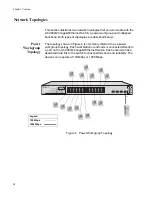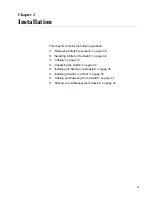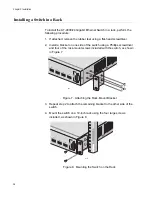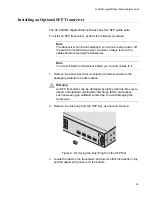
Chapter 1: Overview
24
end node can receive or transmit data, but not both simultaneously, the
end node is operating in what is referred to as half-duplex mode. If an end
node can both receive and transmit data simultaneously, the end node is
said to be operating in full-duplex mode. Naturally, an end node capable of
operating in full-duplex can handle data much faster than an end node that
can only operate in half-duplex mode.
The twisted pair ports on the AT-9000/24 Gigabit Ethernet Switch can
operate in either half-or full-duplex mode. They are IEEE 802.3u-
compliant and use Auto-Negotiation to set the duplex mode setting for you
automatically.
For Auto-Negotiation to operate properly on a switch, the end nodes
connected to the switch should also use Auto-Negotiation. If an end node
does not have this feature and has a fixed duplex mode of full-duplex, the
result will be a duplex mode mismatch between the end node and a switch
port. A port on the Gigabit Ethernet switch connected to an end node with
a fixed duplex mode of full-duplex will operate at only half-duplex. This
results in the end node using full-duplex and the switch port using half-
duplex. This can produce network performance problems. If you
encounter this situation, you must configure the port on the end node to
use Auto-Negotiation or, if it lacks that feature, to half-duplex.
Note
Because the ports on the AT-9000/24 Gigabit Ethernet Switch
operate in Auto-Negotiate mode only, the end nodes connected to
the switch must also be configured to operate in the Auto-Negotiate
mode. If an end node is configured to a specific duplex setting in a
manual mode, it will not respond to the Auto-Negotiate protocol from
the AT-9000/24 Gigabit Ethernet Switch. (The speed is determined
from the link pulses, however, so the speed is always detected
correctly.) As a result, the port setting on the switch will end up at
half-duplex. If the end node is manually configured to full-duplex,
there will be a duplex mismatch and data will be lost. If the end node
is manually configured to half-duplex, both ports will have the speed
and duplex match up correctly.
Store and
Forward
The AT-9000/24 Gigabit Ethernet Switch uses store and forward as the
method for receiving and transmitting frames. When a Ethernet frame is
received on a switch port, the switch does not retransmit the frame out the
destination port until it has received the entire frame and stored the frame
in a port buffer. It then examines the frame to determine if it is a valid
frame. Invalid frames, such as fragments or runts, are discarded by the
switch. This insures that only valid frames are transmitted out the switch
ports and that damaged frames are not propagated on your network.
Back Pressure
and Flow Control
To maintain the orderly movement of data between the end nodes, an
Ethernet switch may periodically need to signal an end node to stop
Summary of Contents for AT-9000/24
Page 1: ...613 000239 Rev A Layer 2 Gigabit Ethernet Switch AT 9000 24 Installation Guide...
Page 6: ...Contents 6 Appendix B Translated Safety Statements 53...
Page 8: ...Figures 8...
Page 10: ...Tables 10...
Page 28: ...Chapter 1 Overview 28...
Page 46: ...Chapter 2 Installation 46...
Page 48: ...Chapter 3 Troubleshooting 48...
Page 52: ...Appendix A Technical Specifications 52...
Page 74: ...Appendix B Translated Safety Statements 74 1 1 2 3 LAN 4 5 6 I 7 8 9 40 C 10 11 15 LAN OFF 12...
















































